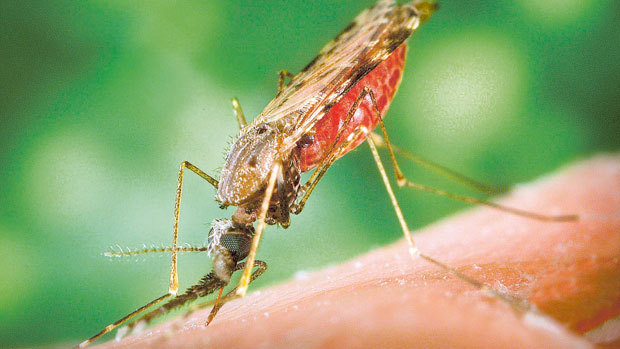
They make that awful whining noise. They leave itchy bites that you scratch until they bleed. And they mean you have to take nasty antimalarial tablets when you go to the tropics on holiday. But if you live in the tropics, especially in Africa, they are much worse than that.
Diseases carried by mosquitoes kill 250,000 people a month globally — for comparison, all violence, from war to murder, causes about 130,000 deaths per month. “We are engaged in a war with mosquitoes,” says Janet Hemingway. “Or not so much with the mosquitoes, but with the diseases they transmit.”
Professor Hemingway, director of the Liverpool School of Tropical Medicine, is a specialist in insect molecular biology who has dedicated her career to finding new weapons for use in that war. It is a war in which we are hugely, incomprehensibly outnumbered. “One female mosquito can lay 160, 200 eggs every two weeks,” she says. “We’re outnumbered by tens of thousands to one; millions.”
But the question is: is it a war we can win? Perhaps it is worth knowing our enemy. Mosquitoes exist everywhere, on every continent except Antarctica, from the Arctic Circle to the equator. There are believed to be 3,500 different species, in 43 separate groups, or genera.
But two of those groups are responsible for the overwhelming majority of disease transmission: Aedes and Anopheles. Aedes mosquitoes carry dengue fever, yellow fever and a viral disease called chikungunya, among other things; Anopheles carries the big killer, malaria, responsible for 2.7 million deaths worldwide a year, endemic to almost half of the globe.
So when did mosquitoes first start appearing? “Those two groups, Aedes and Anopheles, their most recent common ancestor lived about 100 million years ago,” says Professor Luke Alphey, an insect specialist from the department of zoology at Oxford. “The dinosaurs died out 65 million years ago. Mosquitoes are an amazingly ancient group.”
Ancestors of the things that bite you on holiday may have taken blood from triceratops and other creatures of the Cretaceous. At that time, the closest living relative to humans would have been something like a shrew; to you and me, the mosquitoes at the time would have looked like mosquitoes. Mosquitoes, like sharks, hit a long time ago on a lifestyle that worked, and have had little reason to change it since. That lifestyle is quite complex.
Adult mosquitoes lay their eggs in water. Those eggs hatch into little larvae, usually slender things with a little tail-like structure that they put to the surface to breathe; they eat algae and bacteria, and sometimes other insects. When the larvae have eaten enough, they become something called a pupa, a transitional form inside which the adult grows. That adult then flies off, looking for a mate and, if it’s female, something to suck blood from. (Not all mosquitoes do this: for instance, the largest mosquito in the world, the one-and-a-half inch long Toxorhynchites speciosus, the so-called “elephant mosquito”, only eats plant matter as an adult. Its larvae, however, are voracious predators of other mosquito larvae. The males of all species are entirely vegetarian, some of them eating nectar and happily pollinating flowers.)
“It’s a surprise to me that the mosquito lifestyle works so well across so many places,” says Alphey. “Beetles, I can understand that: they have such a wide range of lifestyles, they’re adaptable. But mosquitoes are quite specialised. They breed in water, but not running water; sometimes brackish, but not salt water; many females require a blood meal before they can lay eggs, or before they can lay a second batch of eggs. It doesn’t seem to me to be as robust and flexible a lifestyle as it clearly is. But I’m obviously wrong.”
The sheer success of the mosquito lifestyle over the aeons shows the scale of the problem. “You’re dealing with a really ancient system that has evolved over a very long time, something which is incredibly fine-tuned, so not surprisingly it’s very difficult to disrupt,” says Hemingway. But more than that, the mosquitoes which feed on humans have become especially well adjusted to living with us, in the evolutionary eyeblink in which we have appeared.
“Those species are successful because humans have been successful,” says Nikolai Windbichler, a synthetic biologist working on genetic modification of mosquitoes at Imperial College London. “They are adapted to us and we are their lunch.”
“The dengue mosquito I’ve been working on, Aedes aegypti, it’s now very human-associated, adapted to living in and around human habitation, biting humans and so on,” says Alphey. “They’ve adapted to breed around human refuse, human-stored water, drains.”
Wherever humans live, the specific mosquitoes that have evolved to feed on them will probably live, too. That makes them fantastically hard to get rid of, but there has been success. Windbichler points out that in the past few decades, malaria cases and deaths have dropped by 20 per cent; the disease has been essentially eradicated from North America and Europe. And the news is better than that, as Hemingway says: “In a number of countries, we have won the battle already. It used to be in many more countries than it is today. We’ve pushed it back from the boundaries, we’ve pushed it back in Latin America; places such as Mexico, for instance, there’s very little transmission going on. We’ve pushed it back from parts of Asia; Sri Lanka is almost malaria-free. Thailand is pretty much malaria-free, but used to have very high transmission.”
The way we have done it has been fairly simple: “Reduce the mosquito population and treat the symptomatic people,” says Hemingway. Treating the disease, killing the malarial parasites in the bloodstream, is the job of doctors: but it’s biologists such as Hemingway, Windbichler and Alphey who are on the front lines against the insects. The main weapon in the war against malaria mosquitoes has been nets — simple, fine-mesh mosquito nets that people put over their beds at night. Those nets are impregnated with an insecticide, so any mosquitoes which make it through die before they can bite.
Because Anopheles, the main source of malaria, is active late at night, someone who sleeps under an impregnated net is much less likely to be bitten by a malaria-carrying mosquito. Another method is to spray the rooms and areas with a fog of insecticide, or to remove the pools in which they breed, or to fill those pools with chemicals to kill the larvae. In combination, those methods have been enormously successful at reducing the spread of Anopheles, and thus malaria, worldwide.
There are also less effective methods: Hemingway’s colleagues, she says, “are forever taking people to court” for trying to sell devices that are purported to repel mosquitoes by making a high-pitched buzzing noise. “It’s complete and utter nonsense. They don’t work. But people like the idea of them, and you put a bit of pseudoscience in and people stop taking their antimalarials. We’ve stopped Heathrow Airport selling them several times.” But there are proven methods, and they are having an effect.
All of which sounds very encouraging, but there are also huge problems. First, there is one major region notably absent from our list of successes: sub-Saharan Africa, where the disease is still rife. “The real test is whether we can make a difference there,” says Windbichler. Second, as Hemingway points out, the insecticides kill most mosquitoes — but the ones that survive, and breed, tend to be the ones that have some resistance to that insecticide.
In exactly the same way that antibiotics create antibiotic-resistant bacteria, insecticides create insecticide-resistant mosquitoes. “The quickest I’ve seen mosquitoes develop resistance to a new drug is within six months; the longest is 25 years. In general, you get one or two years, if you’re lucky,” she says.
Windbichler agrees: “We are facing growing resistance to the remaining insecticide classes,” he says. The best way to avoid this is to impregnate each net with several different insecticides, thus reducing your chances of any mosquitoes surviving to breed, but that is expensive. Third, we are talking only about the success of the fight against malaria. As important as it is, it’s only one of the diseases mosquitoes carry. The diseases carried by Aedes are far more intractable.
“Unlike malaria, dengue is actually spreading, in terms of its geographical range and severity,” says Alphey. “It has been for 50 years. That’s pretty unusual for an infectious disease these days.”
One reason is that there are no drugs for dengue, a viral disease which causes nausea, headaches and agonising muscle pains (it’s also known as “breakbone fever”) — no vaccine and no treatment. Doctors can only alleviate symptoms and hope patients get better. Another reason is that bed nets are no use: Aedes mosquitoes are active during the day. Dengue’s death toll is much smaller than malaria’s, although Alphey still puts it in the “tens of thousands”, but it infects about 400 million people a year. It’s a less well-known virus that Alphey is most unnerved by, though: chikungunya.
Aedes mosquito’s eggs can survive being dried out, so they can easily be shipped around the world. “Chikungunya was native to Africa, and there was a great outbreak of it in India in 2007, and just last year it was detected in the Caribbean, and they now have thousands of cases,” says Alphey. And the main mosquito that carries it, “A aegypti”, is all over the Americas, from the south of Brazil to the southern US — and a second species can be found as far north as New York state.
“Nobody in that whole area has any previous exposure to this disease, so there’s no immunity, no antibodies. So I think we can expect big, big outbreaks of that.” Its symptoms include fever, nausea and pain in the joints, and about one sufferer in every 1,000 dies. When Alphey says this, my ears prick up. Huge outbreaks of tropical disease in the United States? That’s not likely, he says, partly for climatic reasons, but mainly because mosquito-borne diseases have one major risk factor: poverty.
“Having a decent piped water supply, as most Western countries do, is a great way of reducing -mosquito populations,” he says: if there isn’t one, people tend to keep open stores of water for washing and drinking, and they are perfect breeding grounds for Aedes. And people in developed countries tend to have sealed houses. But, says Hemingway, “if you’re living in a mud or thatch hut with open eaves and no glass in your windows, it’s very easy for mosquitoes to move in and out”. That is why, even though malaria turns up every so often in the UK, about eight to 10 cases annually — “we call it airport malaria, because it clusters around the ports” — it doesn’t spread.
There are mosquitoes in Britain which can transmit malaria — for instance Anopheles atroparvus, which is common in the salt marshes of Kent. But because our lifestyles are different, our water supplies and houses sealed and modern, it is unlikely to become a threat, even in a hot summer.
So the war against mosquito-borne diseases is closely tied to the war against poverty. That is why malaria in sub-Saharan Africa has been so stubborn, even though it has fallen away everywhere else. “In my lifetime, there’s never been a time in Africa when one or more countries hasn’t had some sort of civil war going on, so if you’ve got a huge continent like that with poor infrastructure, where it’s hard to get at, it’s going to be difficult,” says Hemingway. Mosquitoes, as she points out, “don’t carry passports”, so even if you manage to make great strides in one country, if the country next door is riven with instability, the disease will just come back over the border.
“There was a civil war in Mozambique, and malaria suddenly leapt because the areas we needed to control were heavily mined. Who’s going to go in there and do mosquito control when there are huge numbers of landmines?” There is hope, though. Both Windbichler and Alphey are working on genetic modification of mosquitoes to prevent them spreading disease. “The idea is to breed huge numbers of male mosquitoes that carry lethal genes,” says Alphey. They then fly out into the world, and breed with females, and their offspring would be born with a copy of this gene which would kill them in the egg.
A similar method, using irradiation to sterilise the males, has been successful in various species — “it’s eliminated the screwworm fly on a continental scale”, says Windbichler. There are industrial-scale breeding programmes in Guatemala that produce two tonnes of irradiated flies, about two billion of them, each week.
GM is hoped to be even more effective, because the flies produced won’t be weakened by radiation and so should be more able to find mates. That raises hopes for intractable Africa. “With GM technology you can get the mosquitoes to do the work,” says Hemingway. “They’ll just spread wherever they would go naturally, without humans having to do anything.” There are also parallel programmes that modify the disease parasite rather than the mosquito itself. Trials are taking place, but it’ll be years before GM technology becomes a major tool in the kit.
And even then, we’re not going to wipe out mosquitoes completely, says Hemingway. “It’s just not going to happen — we’re not even trying to,” so people worried that we will upset the delicate balance of the ecosystem can relax. (Even if we did, she says, she doesn’t know of any species that rely entirely on mosquitoes for food, although lots eat the larvae.)
She is pleased about that: “It’s a fabulous insect,” she says, “beautifully built; I wouldn’t have spent 30 years studying them if I didn’t find them interesting.” Alphey is less effusive, saying he respects them, but is not exactly fond. Windbichler says: “They cause immense suffering in the world and they bite us regularly in the lab. So at least for me, Stockholm syndrome hasn’t set in yet.” (Mosquitoes have an especial tendency to bite people with sweatier feet, people with blood type O, — and, for some reason, pregnant women. I don’t know if any of those things apply to Professor Windbichler or his colleagues.)
That annoying whine is the simple product of the frequency of the wing-beat: there’s nothing, it seems, that evolution could do to make it silent. Even despite it, we’re not very good at spotting, or swatting, them; a sleeping human in a mosquito-rich area can easily be bitten 150 times in a night without noticing.
And sometimes you’ll hear the whine, and it won’t do you much good, says Hemingway, with the weary tone of someone who knows. “You’ll be lying there in the dark, you’ll hear this buzzing, you’ll flap your hands around, you’ll think, oh god I’m fed up with this, then you’ll get up and turn the light on and you can’t find the thing. Because what’s happened is it disappears the minute the light goes on and it’s waiting for it to be dark again.”
They have been outwitting us for a hundred million years; they’re really, really good at it.
–The Telegraph Group Limited, London 2014













